Read Reviews
The Best Patio Sealers
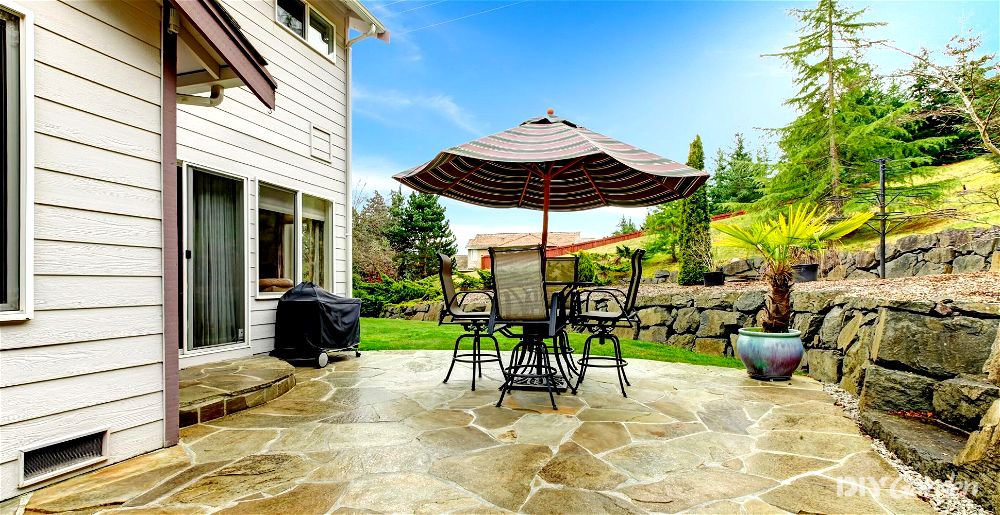
-
Everbuild 405 Path & Patio Seal
-
Sika Patio Paving Sealer
-
Pro-Kleen PatioSeal
-
Wet Look Natural Stone Sealer
-
Bond It Patio Paving Sealer
Patio Sealer Reviews
- Solvent-free formula makes it easier to clear up spillages and also protects grass
- One 25 L container contains enough product for 2 or 3 coats
- Sprays on white so it’s easy to see which areas you have covered
- Finish is slip resistant so your patio will be less hazardous
- Easy to apply with a paint/fence sprayer
- 25 L tub is heavy at nearly 30 kg which makes it difficult to pour product out before applying
- Doesn't create as much of a high-sheen finish as solvent-based sealers
- Available in a 25L tub which weighs nearly 30kg - difficult to carry and dispense
Offering good value for money, this Everbuild 405 Path & Patio Seal comes with enough product to coat a large patio at least twice (if not three times).
The 25 L bottle of solvent-free, acrylic coating is very reasonably priced considering its coverage, and it creates a good finish on the patio.
As long as the patio is thoroughly dry and clean of debris before application, it can produce a non-slip, low-sheen finish which protects the slabs from water, stains and wear. The exact area that one bottle can cover is dependent on the porosity of the patio and how the seal is applied.
The liquid has a low enough viscosity to apply with a paint/fence sprayer, which seems to produce better results compared to using a roller. Using a sprayer is also more economical in terms of product usage. At least two, if not three coats will be required, and it takes at least three hours before the next coat can be applied.
To make things easier, the seal has a slightly milky colour when wet, which makes it possible to see which areas have already been covered. One 25 L bottle should be sufficient for the majority of spaces.
Everbuild state that this seal can be used over patios, paths, concrete and block paving. The instructions also say that the seal can be applied on damp slabs, but this may produce a patchy appearance so it’s best used when they’re completely dry.
Overall, this patio seal creates a quality finish on the patio, and it’s one of the best patio sealers in terms of value for money. The effect isn’t as shiny as some solvent-based sealants, but it protects slabs against stains, UV rays and water damage. Plus, it won’t kill the grass if it accidentally comes into contact with it.
Did you find this review helpful?
- Quick drying and a second coat can be applied in two hours
- Creates a slight gloss finish on stone, or high-gloss finish if three coats used
- Extremely water resistant
- Contains a fungicide, reducing build up of mould and algae
- Much easier to clean dirt off patio after sealer has been used
- May need to buy more than one bottle in order to complete patio with sufficient coats
With an included fungicide, the Sika Patio Seal is one of the best patio sealers for protecting the patio and stopping any slippery moulds grow over the colder months.
If your patio is prone to attacks from green mould and algae, perhaps because it’s positioned in the shade or you live in a damp area, this seal can help prevent excessive build up.
The water-based acrylic coating can be used on paths, patios, natural stone and concrete, protecting the surfaces from rain, oil, sun and organic growth. It gives quite a glossy finish, especially when two or three coats are applied. However, if your patio is quite porous, you may find that with just one coat it’s still relatively matt.
The 5 L container is sufficient to cover an area of approximately 40 m² (with one coat), although this also varies depending on the porosity of the stones. It’s quite a runny liquid, and a lot can go a long way. It can be applied with either a sprayer, brush or roller, with a sprayer generally being the most economical method. Approximately two hours are needed between coats.
Once dried, the Sika Patio Seal is very resistant to water, and it brings out the colour of slabs with its slightly glossy finish. The sealer is sufficiently high-gloss to shimmer in the sunlight, which may or may not be desirable depending on personal preference.
The patio also becomes much easier to clean after using the seal, and dirt like bird dropping are much easier to remove simply with water and a soft brush.
Did you find this review helpful?
- Produces a clear matt finish that stands the test of time
- Great for BBQ areas as it will prevent staining from oil, fat and grease
- A little goes a long way - 5L can cover up to 50m² of patio
- Needs to be applied very carefully and evenly or the result is patchy
If you want to avoid a gloss finish, the Pro-Kleen PatioSeal dries matt, leaving almost no trace on the paving at all.
Whereas the majority of sealers leave a mid to high-gloss finish, the Pro-Kleen PatioSeal barely alters the appearance of the stones. This makes it one of the best patio sealers on the market if you want to achieve a matt look on your patio.
It comes as 2 x 5 L bottles, which, according to the manufacturer, is sufficient to cover 100 m² (each bottle covers 50 m²). However, in reality it is unlikely to achieve such expansive coverage.
Customers report that using a fine sprayer is the best way to apply this seal, in order for it to give the best finish and be economical with the product. Drips and splashes will result in uneven coverage, so care needs to be taken to apply it evenly.
PatioSeal creates a layer over the stones that makes them easier to clean, and it can help repel dirt, water, and oil. If you like to have BBQs on your patio during summer, but hate the messy grease stains that they leave behind, the surface should get much fewer stains after applying this sealer.
It dries quickly, becoming rain-fast after three/four hours and completely cured after approximately twenty-four.
Although PatioSeal is suitable for Indian sandstone, patios, paths, concrete and brickwork, it shouldn’t be used on lime-based materials.
Did you find this review helpful?
- Quick drying time and a second coat can be applied after one hour
- Revives the look and original colour of patio stones and paving
- Suitable for both indoor and outdoor use - conservatories, kitchens, patios, etc.
- Acrylic-based formula has a low odour that isn't overwhelming indoors
- Patio needs an extremely thorough clean before application or the results will be poor
- Need to be very careful not to let the solution pool on the floor during application
Suitable for use on both interior and exterior surfaces, this Black Diamond Stoneworks Wet Look Stone Sealer creates a natural wet-look finish and brings out the original colour of the stonework.
It can be used in bathrooms and kitchens with stone or slate floors, as well as on concrete, slate, patios and other porous surfaces. The finished effect looks as though the stone is damp, which brings out richer tones and colours.
A single coat may be sufficient for some uses indoors, but for the most part at least two (if not three) coats will be required. The more coats that are used, the glossier the finish. It can be applied with either a roller, brush or sprayer, and the liquid has a reasonably low viscosity.
During application, the acrylic-based sealer shouldn’t be allowed to pool, as this can lead to white spots and marks remaining visible once it dries. If spraying on an uneven surface, it can be more difficult to ensure no puddles form, and a brush may be required as well as a sprayer.
Although the majority of sealers featured on this page are fast-drying, the Stoneworks Wet Look Stone Sealer is particular quick, and a second coat can be applied after just one hour.
The 3.785 L (1 gallon) bottle contains enough sealer to do a couple of coats on the majority of small/medium patios, but a larger amount may be required for bigger areas.
Given that it can be used for both interior and exterior surfaces, and has a low odour that isn’t overwhelming inside, this is one of the best patio sealers for both indoor and outdoor use. If you have any stonework that is looking a little dull, this can brighten it up. It’s also particularly effective on darker colours.
Did you find this review helpful?
- Goes on easily with either a brush or a roller
- Solvent-free and does not have a strong odour
- Both enhances the look and protects your patio from bad weather
- Slows down and limits algae growth on the patio
- Good value considering price and amount of product
- Will leave white marks if applied in too high a concentration
- Can't be applied using a sprayer
One of the best sealants to buy on a budget, the Bond It Patio Paving Sealer comes in a 5 L bottle and brings out the natural colour of paving stones without breaking the bank.
Compared to some other makes, it’s markedly less expensive, especially considering that you still receive a reasonable amount in the bottle.
As a solvent-free, acrylic based formula, the sealer has a limited odour and is relatively easy to apply. It can be used over many different patio surfaces including sandstone, limestone and concrete. On most surfaces, it dries to a clear and subtle matt sheen finish with limited gloss.
Application can be done with a paintbrush or roller, and it spreads on easily. As with the majority of these products, if the sealer is allowed to pool during application, it will leave white marks when it rains – so beware!
The Bond It Patio Paving Sealer is also relatively effective against the growth of mould and algae. Although it may not stop it from growing altogether, customers have reported noticing a dramatic decrease in the amount of mould present on their patio.
It creates a good seal against rain and water damage, and can also protect the patio or driveway from oil and petrol marks.
Did you find this review helpful?
How to Choose the Best Patio Sealer
Patio sealer can help protect your patio from signs of weathering, as well as improve its appearance.
If your patio is starting to look a little dull and tired, patio sealer can give it a new lease of life, adding a gloss or matt finish to the stones and improving the richness of their colour.
You’ll need to make sure that you get the best patio sealer for the type of stones you want to seal, and ensure that it will achieve the effect you’re after.
The following information will help you make an informed decision when looking for a patio sealer, as well as give you tips on how to use it.
READ NEXT: Best Modern Garden Patio Ideas
What Patio Sealer Does for Your Patio
Patio sealer has a range of benefits for your patio. Here are some of the most common:
- Protect paving from UV rays
- Protect paving from general weather damage
- Prevent or reducing the amount of algae and mould that grow on the patio
- Improve the appearance of stones and giving the patio a new lease of life
- Protect stones from spillages such as oil, grease and petrol
- Make dirt easier to clean off the patio
As you can see, using paving sealant can extend the life of your patio, as well as improve its appearance.
Adding a protective sealant can make it a lot easier and quicker to clean the patio, and ensure that grease marks from BBQs, cars or bikes don’t permanently stain the porous surface of the stones. If you find yourself constantly cleaning your patio and having to put a lot of effort into doing so, using a patio sealer could dramatically reduce the time spent on this job.
READ NEXT: The Best Patio Cleaner
Different Types of Patio Sealer
Gloss vs Matt
Depending on the finished ‘look’ that you want for your patio, you will need to choose between a gloss or matt sealer.
Gloss sealers can offer a range of finished, from a light sheen, to a ‘wet look’, to high gloss. Most people who are looking for a relatively subtle gloss on their patio want to achieve the ‘wet look’. This is designed to replicate the richer, darker appearance that paving gains after rainfall.
The more coats of gloss sealer that are applied, the glossier it will be. Most products recommend using two to three coats of sealer. One coat may not be enough to create a durable seal.
Matt sealers are designed to give a gloss-free finish; however, some are better at achieving a matt effect than others. If you are after a truly matt finish, the best thing to do is read customer reviews from using matt products. This will give a true impression as to whether the final finish of the sealer is genuinely matt, or has a slight sheen.
The best patio sealers for creating a matt finish are ‘impregnating’ sealers that seal the holes in the porous patio material instead of adding a protective layer over the top.
Solvent Based vs Non-Solvent Based
Patio sealers are either solvent based, or water based. But which is better?
Water-Based Sealers
Water-based sealers are mixed with a resin. This resin might be acrylic or polyurethane. Because they are water based, these sealers do not have as strong a smell as solvent-based sealers, making them more pleasant to use.
Sealers with polyurethane are more likely to hold a gloss finish for longer than acrylic.
Here are some advantages of using water-based sealer:
- Tools and spills can be cleaned with water
- Generally not as expensive as solvent-based sealer
- Less likely to kill or damage plants if product lands of them by accident (easily done when applying with a spray)
- Can be more suitable for indoor use, or just more pleasant to apply in general, as there’s less smell
- Can often be applied with a sprayer
And here are some disadvantages:
- Takes longer to dry than solvent-based sealers as the solvent is what helps reduce curing time
- May not create as long lasting a seal as solvent-based sealers and reapplication may be required more frequently
Solvent-Based Sealers
Like water-based sealers, solvent-based sealers are also mixed with either acrylic or polyurethane resin. Instead of water, these resins are mixed with solvents like xylene.
Solvent sealers with polyurethane create a particularly tough seal. It’s a good choice to go for if you want an extremely high gloss finish, as the gloss doesn’t dull easily over time.
Solvent sealers with acrylic are a slightly cheaper option, although they still penetrate well into the paving. They are not quite as long lasting as solvent sealers with polyurethane.
Here are some advantages of using solvent-based sealer:
- May be able to get away with using just one coat, especially if after a matt finish
- Generally tougher and longer lasting than water-based sealers
- (Specific to polyurethane solvent-based sealers) Holds gloss for a long time
And here are some disadvantages:
- Stronger odour than water-based sealers whilst applying
- Harder to clean brushes, rollers and other equipment – especially if allowed to dry
READ NEXT: Best Modern Porcelain Patio Ideas
Applying Patio Sealer
To give yourself the best chance of successfully applying patio sealer, you need to choose the right time of year as well as a dry weather window.
In terms of conditions, most sealers shouldn’t be applied if either the air or surface temperature is below 5°C. You should also avoid applying the sealer if temperatures are above 30°C.
The best time to apply patio sealer is at the end of spring, or during the summer. This is because you need a period of several dry days in order to prepare the patio as well as allow the sealer to dry.
First and foremost, you should make sure to follow the instructions on the specific sealer that you have purchased, including wearing any necessary safety gear. However, these are some general tips for application (including adding additional jointing sand which may be more relevant to older patios):
- Choose dry time of year. As mentioned, you need a dry spell (preferably of at least a week) when applying patio sealer to make sure you get the best results.
- Deep clean the patio approximately one week before applying the sealer. This means power washing the slabs, clearing all dirt, and weeding.
- Leave to dry thoroughly for at least a week before continuing, you want any sand in the joints to be dry before you continue.
- Once the day arrives to seal the patio, check there’s 24 hours of dry weather. Remove any weeds etc. that have grown in this time
- Sand the joints – brush jointing sand into all of the joints – don’t rush this job and take care to apply sand evenly
- Thoroughly clean excess sand once joints are refilled and level
- Choose the application method for the sealant depending on product’s recommendations – ideally use a roller or sprayer, but have a paintbrush on hand to smooth out any pools of liquid
- Make sure the product gets evenly over the joints as well as all other areas of the patio
- Apply two to three coats (depending on instructions) and leave sufficient time to dry between coats.
- After final coat, make sure patio will be protected from rain for several hours. Ideally leave 24 hours of no rain and no traffic on the surface to ensure a full cure.
READ NEXT: The Best Patio Grout
Patio Sealer FAQs
Water-based patio sealer is generally considered better for the environment, and may not cause as much damage to your grass or plants if it gets on them accidentally. It’s also easier to clean rollers, brushes and equipment. However, water-based sealer does not permeate as far into the paving as solvent-based sealer, meaning reapplication may be required more regularly.
Solvent-based patio sealer generally creates a tougher seal that will last longer. Also, solvent-based sealer with polyurethane maintains its gloss for a long time.
Late spring or summer are the best times of year to apply patio sealer. Ideally, you need at least a week of dry weather – first to make sure that the patio is completely dry before applying the sealer, and second to leave at least 24 hours after applying the sealer for it to cure well.
However, avoid applying patio sealer if the weather is too humid, or if temperatures are over 30°C.
Patio sealer also shouldn’t be applied if the temperature of the air or surfaces are below 5°C.
The best thing to do is test the patio sealer on a small corner of patio, before committing to covering the whole space. Although this might sound like a waste of energy when you just want to get on with the job, certain sealers can be a lot glossier than you might like and it’s good to find this out early on.

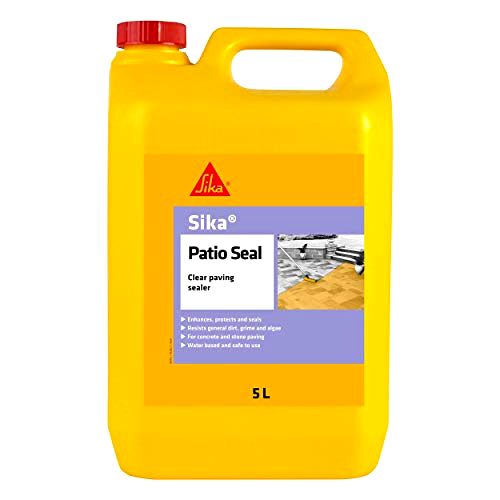
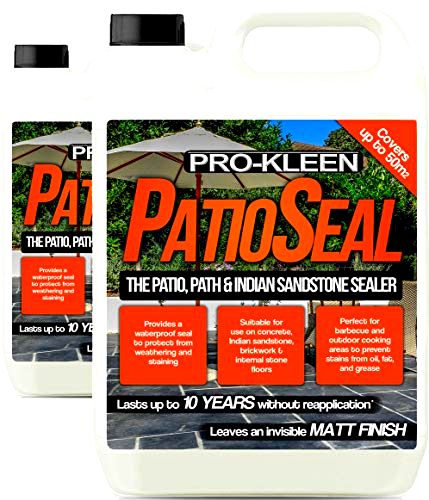
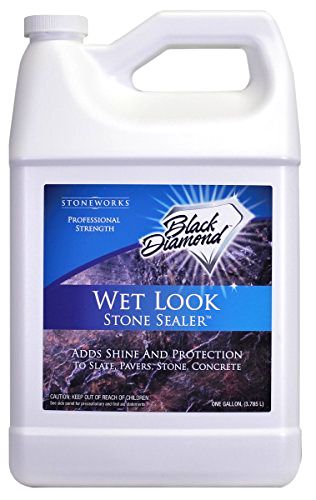
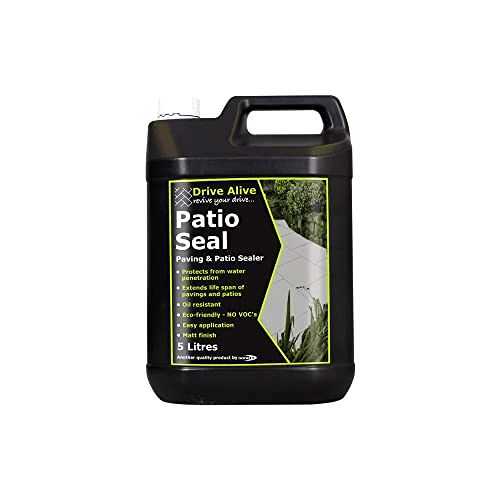

Share